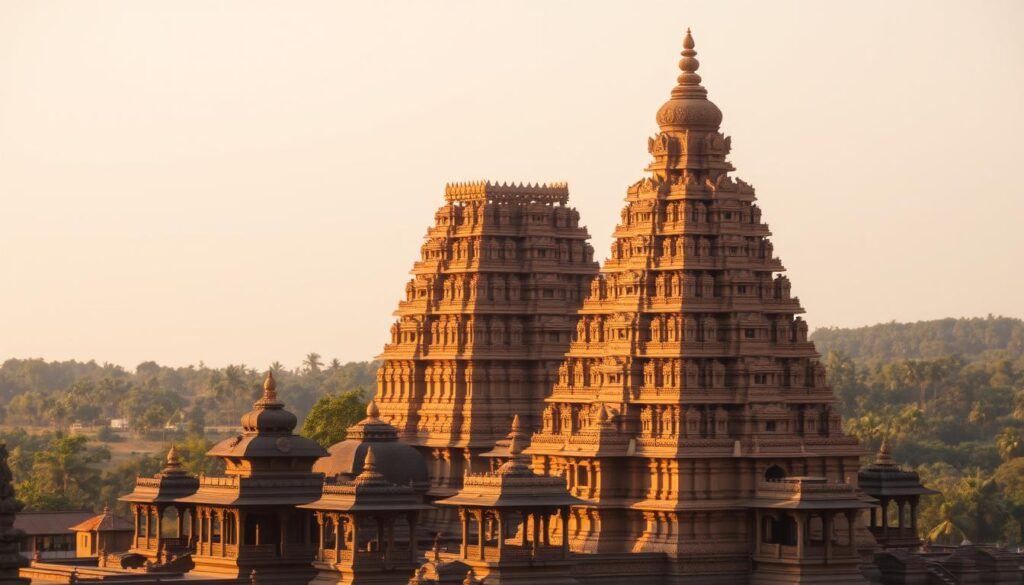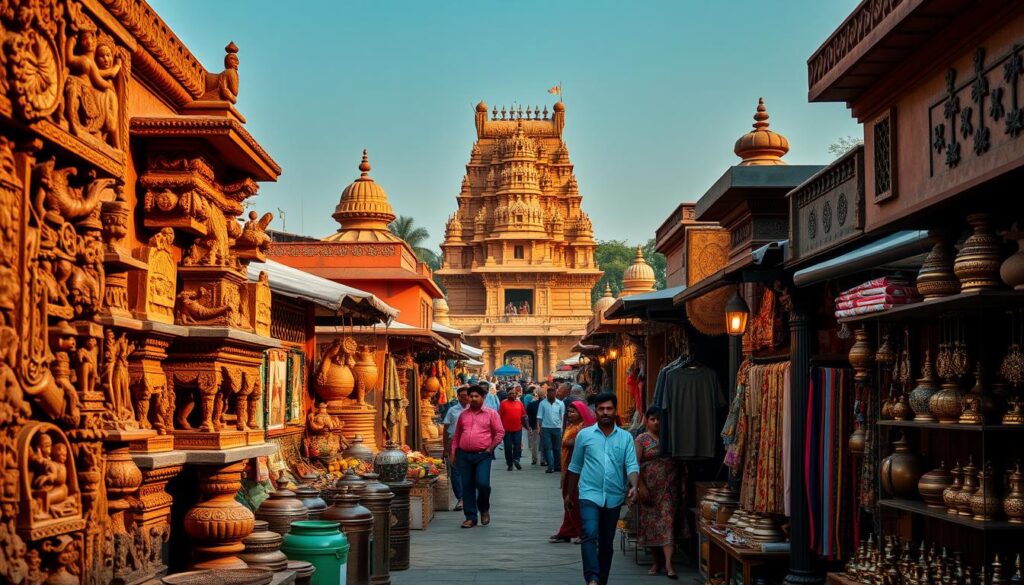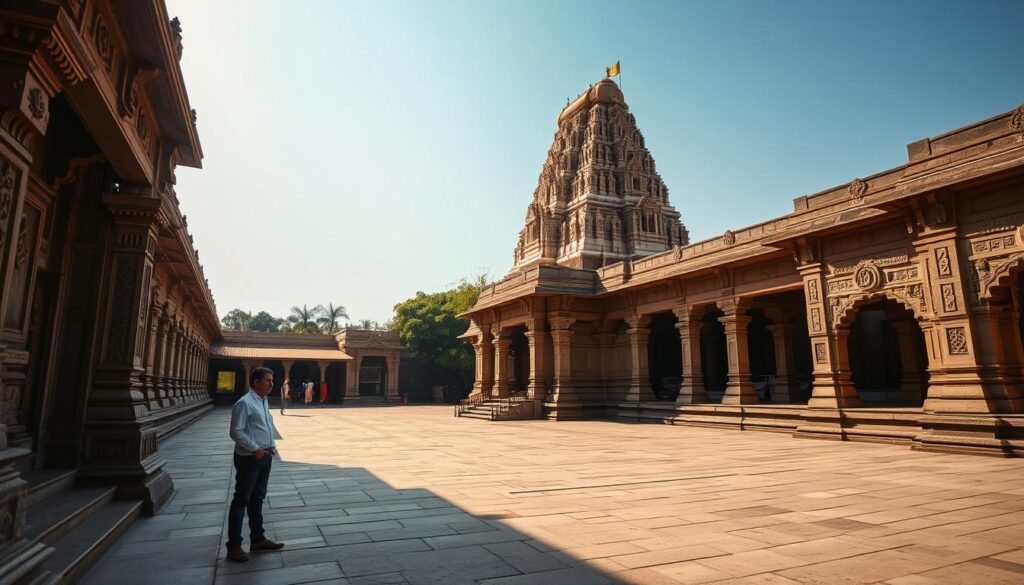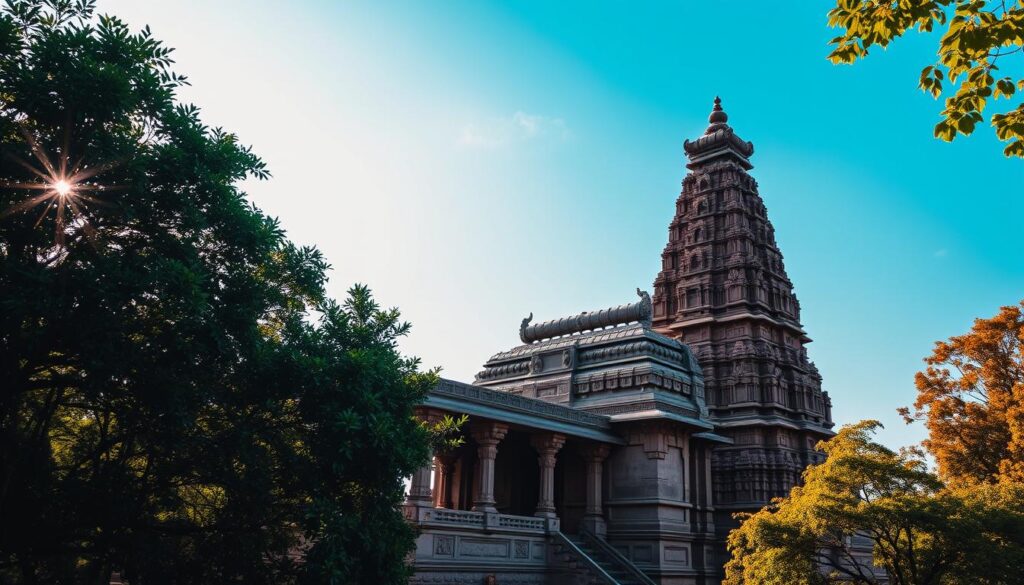In the heart of Karnataka, India, lies a hidden treasure. It takes you back in time to a world of ancient history and stunning architecture. Halebidu is a place filled with over a thousand years of rich culture, waiting to be discovered.
When you enter this ancient town, you’ll be amazed by the detailed carvings and sculptures on its monuments. The Hoysaleswara Temple stands out as a symbol of the region’s glorious past.
Your trip to Halebidu will be an adventure you won’t forget. It’s a journey filled with discovery and excitement. Get ready to uncover the secrets of this incredible place.
Key Takeaways
- Discover the rich history and cultural significance of Halebidu’s monuments.
- Explore the breathtaking architecture of the Hoysaleswara Temple.
- Learn about the best times to visit and practical logistics for your trip.
- Uncover the hidden gems and off-beaten paths in and around Halebidu.
- Experience the unique cultural heritage of Karnataka, India.
Introduction to Halebid
Halebid, meaning ‘old city,’ is a treasure trove of historical monuments and architectural marvels. It’s located in the Hassan district of Karnataka, India. Here, you can journey through time and explore the remnants of a bygone era.
A Brief History of Halebid
Halebid was once the capital of the Hoysala Empire. This empire ruled over a significant part of Karnataka from the 11th to 14th centuries. The town is famous for its Hoysala architecture, known for intricate carvings and detailed sculptures.
As you explore Halebid, you’ll learn about its history and its impact on Indian art and culture. The Hoysala Empire played a key role in shaping southern India’s architectural landscape. Their legacy can be seen in the temples and monuments across Halebid and nearby Belur.
Significance of Hoysala Architecture
Hoysala architecture is known for its intricate carvings and detailed sculptures. These often depict scenes from Hindu epics like the Ramayana and Mahabharata. The temples in Halebid, such as the Hoysaleswara Temple, showcase the artistic prowess of the Hoysala craftsmen.
The significance of Hoysala architecture goes beyond its beauty. It reflects the tolerant and inclusive nature of the Hoysala Empire. Exploring the temples in Halebid gives insights into the religious and cultural practices of the time.
| Aspect | Description | Significance |
|---|---|---|
| Historical Context | Halebid was the capital of the Hoysala Empire | Understanding its past glory |
| Architectural Style | Intricate carvings and sculptures | Reflects artistic and cultural heritage |
| Religious Influence | Blend of Hindu and Jain elements | Highlights religious tolerance |
Visiting Halebid is a unique chance to experience where history, art, and culture meet. As you plan your trip, you’ll see why Halebid is a must-see for anyone interested in India’s rich heritage.
The Temples of Halebid

As you enter Halebid, you step into a world of ancient temples. They tell stories of a long-lost time. The town is famous for its historical sites, like the stunning Hoysala architecture.
Your visit to Halebid will be a feast for your eyes and mind. You’ll see architectural wonders that showcase the town’s rich culture.
Chennakesava Temple: A Masterpiece
The Chennakesava Temple stands out for its Hoysala craftsmanship. Its walls and pillars are covered in intricate carvings and detailed sculptures. This temple is more than a place of worship; it’s a work of art.
Walking through, you’ll see vibrant depictions of mythological scenes. The skill with which they were made is truly impressive.
Hoysaleswara Temple: An Architectural Marvel
The Hoysaleswara Temple is a stunning example of Hoysala art. It’s filled with carvings and sculptures that tell stories from Hindu mythology. Its star-shaped platform and detailed surfaces make it a standout.
Exploring this temple, you’ll learn about Hoysala architecture and its cultural background. The temple’s design shows the advanced skills of the artisans back then.
The detailed friezes and sculptures show different aspects of life and mythology. The Hoysaleswara Temple is a key site in Halebid. It offers a glimpse into the region’s cultural heritage and the Hoysala dynasty’s architectural skills.
Unique Features of Hoysala Temples
The Hoysala temples in Halebid showcase the Hoysala dynasty’s architectural skill. As you explore, you’ll see the details that make them special.
Intricate Carvings and Sculptures
The Hoysala temples are famous for their detailed carvings and sculptures. They show scenes from Hindu myths and everyday life. These carvings highlight the Hoysala craftsmen’s talent and give a peek into the past.
The intricate carvings on the walls and ceilings are a highlight of the Hoysala temples, making them a fascinating subject for study and admiration.
Religious Symbolism in Architecture
The Hoysala temples’ architecture is full of religious symbols. From deities to mythological stories, every part of the temple has spiritual meaning.
| Symbolism | Description | Significance |
|---|---|---|
| Carvings of Deities | Intricate carvings depicting various Hindu deities | Representation of divine presence |
| Mythological Scenes | Scenes from Hindu mythology carved on walls | Conveying moral and spiritual teachings |
| Geometric Patterns | Intricate geometric patterns adorning the temples | Representing the harmony and order in the universe |
Visiting the Hoysala temples in Halebid is a rewarding experience. It offers a look into India’s rich cultural and spiritual heritage.
Best Time to Visit Halebid
Wondering when to visit Halebid? It’s all about the climate and cultural events. This ancient town is famous for its temples and rich culture. The right time to visit can make your trip even better.
Seasonal Weather Considerations
The best months to visit Halebid are October to March. The weather is cool and perfect for exploring. You can see the temples’ detailed carvings without the summer heat.
Weather Conditions:
| Season | Months | Weather Conditions |
|---|---|---|
| Winter | October to February | Cool and pleasant, ideal for sightseeing |
| Summer | March to May | Hot and dry, less ideal for outdoor activities |
| Monsoon | June to September | Heavy rainfall, some attractions may be inaccessible |
Local Festivals and Events
Visiting during local festivals adds a special touch to your trip. Halebid celebrates many festivals, like the Holebasavanahalli Festival. These events offer a glimpse into the local culture and traditions.
Plan your visit to coincide with these festivals. You’ll get to see Halebid’s vibrant culture. Plus, you can try the local food and talk to the people.
Getting to Halebid
Your journey to Halebid starts here, with many ways to get there. This place is famous for its beautiful Hoysala temples. It’s easy to plan your trip because it’s close to railways and airports.
Transportation Options from Major Cities
Halebid is easy to reach by bus, train, or car from big cities. Here’s how you can get there:
| City | By Bus | By Train | By Car |
|---|---|---|---|
| Bangalore | Regular buses, approx. 4 hours | Nearest station: Hassan (30 km from Halebid) | Approx. 220 km, 4-5 hours |
| Mysore | Frequent buses, approx. 3.5 hours | Nearest station: Hassan | Approx. 180 km, 3.5-4 hours |
Local Transportation in Halebid
After you get to Halebid, moving around is simple. Auto-rickshaws and taxis are everywhere. They help you see all the temples and attractions.
Tips for Travelers: Rent an auto-rickshaw for the day. It makes exploring the temples and sites easy without worrying about how to get there.
Accommodations in Halebid

Halebid has many places to stay, from luxury to budget-friendly. You can find a spot that fits your needs and wallet. Your trip to Halebid will be comfortable.
Top Picks for Hotels and Guesthouses
For a great stay, check out top hotels and guesthouses. They offer great amenities and services. You’ll enjoy stunning views and easy access to attractions.
Recommended Hotels: Choose hotels that mix comfort with local charm. They often have traditional architecture, giving you a real cultural feel.
Budget-Friendly Options
Travelers on a tight budget can still find good places to stay. Halebid has guesthouses and lodges with basic amenities at low prices. Book early, as prices go up during peak seasons.
Tips for Budget Travelers: Stay at locally owned guesthouses. They’re cheaper and give you a true taste of local culture.
Book your stay in Halebid early to avoid problems. With many options, you’ll find the perfect place for your trip and budget.
Local Cuisine of Halebid
As you explore Halebid’s ancient streets, you’ll find the flavors of Karnataka. The local food shows the region’s rich history. It combines traditional dishes that are both familiar and unique.
Must-Try Dishes
Halebid’s food scene is all about traditional Karnataka cuisine. It’s known for its simple yet flavorful dishes. Here are some dishes you must try:
- Masala Dosa: A fermented crepe filled with spiced potatoes, served with coconut chutney.
- Idli: Soft, steamed rice cakes, often enjoyed with sambar and chutney.
- Filter Coffee: A strong coffee made from freshly ground beans, a Karnataka favorite.
These dishes will delight your taste buds. They also offer a peek into the local culture and traditions.
Popular Local Restaurants
To taste authentic Halebid flavors, check out local restaurants and eateries. Here, you can enjoy traditional meals in a setting that shows local hospitality.
“The best way to get to know a place is through its food. In Halebid, the local cuisine is not just about sustenance; it’s an experience that connects you to the land and its people.”
Popular spots include eateries serving traditional Karnataka thalis and street food stalls with various snacks.
Cultural Significance of Halebid

When you enter Halebid, you’re stepping into a world of history and culture. This place is famous for its beautiful monuments and lively traditions. It shows the deep heritage of India through its detailed carvings, sculptures, and colorful festivals.
Traditional Arts and Crafts
Halebid is known for its traditional arts and crafts. These show the talent and hard work of local artisans. The town is famous for its detailed stone carvings and sculptures on temples and monuments. Traditional crafts include:
- Stone carving
- Woodwork
- Handloom weaving
These crafts are more than just art. They are a big part of the local culture. Visitors can see artisans making beautiful pieces that show the area’s rich heritage.
Festivals Celebrated in Halebid
Halebid’s festivals bring the town to life. These festivals celebrate the area’s diverse culture with music, dance, and rituals. Some important festivals in Halebid are:
| Festival | Description | Time of Year |
|---|---|---|
| Holi | Celebration of colors | March |
| Diwali | Festival of lights | October/November |
| Ugadi | Kannada New Year | March/April |
These festivals give a peek into Halebid’s cultural importance. They show the community’s spirit and traditions. Visitors are invited to join these festivals to feel the town’s vibrant culture.
Exploring Surrounding Areas
Beyond the temples of Halebid lies a world of discovery. Nearby towns and natural wonders await. The region is rich in history, culture, and natural beauty. It’s perfect for travelers looking for a diverse experience.
Nearby Towns Worth Visiting
One notable town near Halebid is Belur. It’s famous for its Chennakesava Temple, a masterpiece of Hoysala architecture. Belur showcases the region’s rich cultural heritage with its intricate carvings and sculptures.
Belavadi is another town worth visiting. It’s known for its Veeranarayana Temple, a 12th-century temple dedicated to Lord Vishnu. The temple’s architecture and carvings highlight the artisans’ skill from that era.
| Town | Main Attraction | Distance from Halebid |
|---|---|---|
| Belur | Chennakesava Temple | 16 km |
| Belavadi | Veeranarayana Temple | 28 km |
| Halebidu | Hoysaleswara Temple | – |
Natural Attractions Around Halebid
Nature lovers will find plenty to enjoy around Halebid. The Yagachi Dam is a significant attraction. It offers scenic views and a chance to enjoy water activities.
The area is also dotted with other natural attractions. It’s ideal for those who want to explore culture and enjoy outdoor activities.
Exploring the areas around Halebid reveals each location’s unique charm and attractions. Your travel experience will be unforgettable.
Travel Tips for Halebid

Getting ready for your trip to Halebid? Here are some tips to make your visit better. It’s key to know about the weather and local culture of this historic town.
Essential Packing List
What you pack can greatly affect your trip. Here are some must-haves:
- Comfortable clothes and sturdy shoes for temple exploring
- Sunscreen, a hat, and sunglasses for sun protection
- A camera to take photos of the carvings and sculptures
- A water bottle to stay hydrated
- A light jacket for cooler mornings and evenings
| Item | Importance | Remarks |
|---|---|---|
| Comfortable clothing | High | Loose, breathable clothes are best |
| Sunscreen | High | Keeps you safe from the sun |
| Camera | Medium | For capturing the temples’ beauty |
Local Customs and Etiquette
Knowing and respecting local customs is vital in Halebid. Here are some tips:
Temple Etiquette: Take off your shoes before entering temples. Dress modestly to honor the local culture.
By following these customs, you’ll have a more meaningful visit to Halebid.
Conclusion: Why Halebid Should Be on Your Travel List
Halebid is a hidden gem that offers a unique blend of history, culture, and natural beauty. It’s a must-visit destination for travelers. Consider adding it to your travel plans for an unforgettable experience.
With stunning monuments and a rich cultural heritage, Halebid is awe-inspiring. You’ll find everything from intricate carvings to vibrant local festivals. There’s something for every kind of traveler in Halebid.
Discover the Secrets of Halebid
So, why visit Halebid? It’s a treasure trove of history, architecture, and culture. Pack your bags, grab your camera, and get ready to uncover its secrets. With its unique blend of traditional and modern attractions, Halebid is sure to be a highlight of your travels.
FAQ
Q: Where is Halebid located?
A: Halebid is in Karnataka, India. It’s part of the Hassan district.
Q: What is the best time to visit Halebid?
A: October to March is the best time. The weather is nice, perfect for temple visits.
Q: How do I get to Halebid?
A: You can get there by bus, train, or car. There are many options from big cities.
Q: What are the must-see attractions in Halebid?
A: The Hoysaleswara Temple is a top spot. It’s famous for its detailed carvings and star-shaped platform.
Q: What are the accommodation options in Halebid?
A: Halebid has many places to stay. You can find budget guesthouses, mid-range hotels, and luxury resorts.
Q: What is the local cuisine of Halebid like?
A: The local food is a mix of traditional Karnataka dishes. You’ll find masala dosa, idli, sweets, and filter coffee.
Q: What are some nearby attractions to visit?
A: Nearby, you can visit Belur and Yagachi Dam. They offer great experiences and discoveries.
Q: What are some essential items to pack for a trip to Halebid?
A: Pack comfy clothes, sunscreen, and a hat. Remember to respect local customs, like removing shoes in temples and dressing modestly.
Q: Are there any local festivals or events in Halebid?
A: Yes, Halebid has many festivals. They show the community’s spirit and traditions.
Q: Where can I stay in Belur Halebid?
A: You can find many places to stay in and around Belur Halebid. Options range from budget-friendly to luxury resorts.
Read More Articles;
- Kaas Plateau Travel Guide 2026: Best Time to Visit, Bloom Season, How to Reach & FAQs
- What Is the Quirimbas Archipelago Mozambique Known For? Complete Travel & Nature Guide
- Is Angola Safe to Travel in 2025? Your Essential Guide to Health, Crime, and Landmine Safety
- What Animals Live in Bale Mountains Ethiopia? Complete Wildlife Guide
- What to Do in Damaraland — Complete Travel Guide for First-Timers

